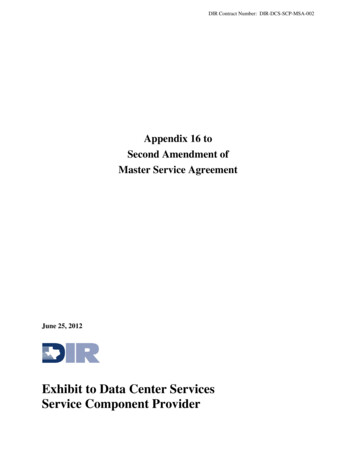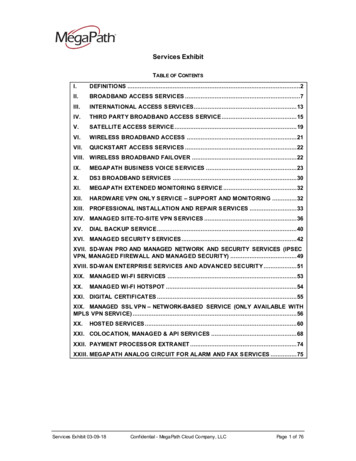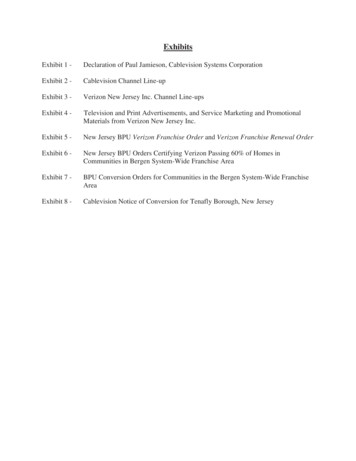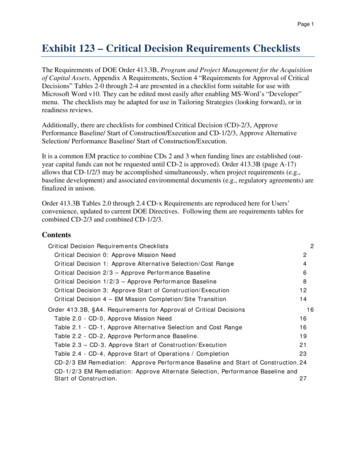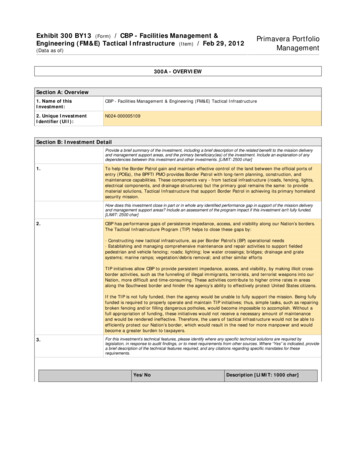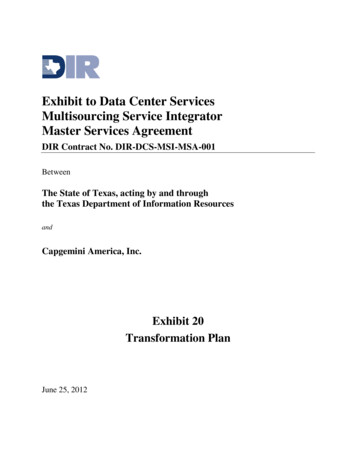
Transcription
Exhibit to Data Center ServicesMultisourcing Service IntegratorMaster Services AgreementDIR Contract No. DIR-DCS-MSI-MSA-001BetweenThe State of Texas, acting by and throughthe Texas Department of Information ResourcesandCapgemini America, Inc.Exhibit 20Transformation PlanJune 25, 2012
DIR Contract No. DIR-DCS-MSI-MSA-001TABLE OF CONTENTSEXHIBIT 20 TRANSFORMATION PLAN . 4Update Methodologies and Attachments to Exhibit 20 . 4The following update methodologies and attachments are incorporated as part of Exhibit 20: . 41.TRANSFORMATION MANAGEMENT. 51.1Introduction . 51.2Document Overview. 52.TRANSFORMATION GUIDING PRINCIPLES. 63.TRANSFORMATION OVERVIEW . 74.3.1Transformation Plan . 83.2High-level Sequence for Transformation Activities . 8STABILIZATION PROJECTS OVERVIEW . 104.1Backup and Recovery Assessment & Remediation. 104.2Problem Management Backlog . 104.3Service Request Backlog. 114.4Solution Request Backlog . 124.5Chargeback Management Stabilization . 134.6Configuration Management . 134.7IT Service Continuity Management (ITSCM) . 134.8Additional Solutions. 14Availability Management . 14Capacity Management. 14Capacity Management – Phase Two (2) . Error! Bookmark not defined.5.CONSOLIDATION OVERVIEW. 155.16.DCS Consolidation – A Program Management Approach . 15OPTIMIZATION OVERVIEW . 16Continuous Improvement – Six Sigma and Lean IT . 167.SERVICE PROVIDER ROLES AND GOVERNANCE ALIGNMENT. 177.1Integration with DCS Governance . 177.2Activities needed for Governance . 177.3Reporting that supports Governance . 187.4Annual Transformation Plan . 18Exhibit 20 Transformation PlanPage 2 of 24
DIR Contract No. DIR-DCS-MSI-MSA-0018.TRANSFORMATION APPROACH AND PROJECT METHODOLOGY . 198.1PMO Structure and Methodology . 198.2PMO Tools . 209.10.QUALITY CONTROL AND GENERAL RISK MITIGATION . 21COMMUNICATIONS. 23Exhibit 20 Transformation PlanPage 3 of 24
DIR Contract No. DIR-DCS-MSI-MSA-001EXHIBIT 20TRANSFORMATION PLANUpdate Methodologies and Attachments to Exhibit 20The following update methodologies and attachments are incorporated as part of Exhibit 20:TitleExhibit 20 TransformationPlanAttachment 20-ATransformation MilestonesExhibit 20 Transformation PlanMethodology for Updating Associated Exhibit AttachmentsExhibit 20 is updated in accordance with Section 4.3(b) ofthe MSA.Attachment 20-A shall be updated in accordance withSection 4.3(b) of the MSA.Page 4 of 24
DIR Contract No. DIR-DCS-MSI-MSA-0011.TRANSFORMATION MANAGEMENT1.1IntroductionIn accordance with Section 4.3 of the Agreement, this Exhibit 20 and the attachedAttachment 20-A collectively constitute the Transformation Plan, and references to theTransformation Plan in this Agreement (including this Exhibit) shall be read andunderstood to collectively mean this Exhibit 20 and the attached Attachment 20-A.Service Provider shall maintain and implement the Transformation Plan, and anymodifications to the Transformation Plan shall be subject to DIR’s review and approvalin accordance with Section 4.3 of the Agreement.The provisions of the Transformation Plan are in addition to, and not in lieu of, theterms and conditions contained in the body of the Agreement and the other Exhibits andAttachments thereto; provided however, unless otherwise expressly stated, theprovisions of this Transformation Plan shall not control over conflicting provisions ofthe Agreement. Unless otherwise expressly defined in the Transformation Plan,capitalized terms used in the Transformation Plan shall have the meaning assigned tothem elsewhere in the Agreement.The dates in this document are intended to provide context and set expectations for thesolutions described. Actual milestone dates are contained in the appropriate milestonedocuments (Attachment 19-A Transition Milestones and Attachment 20-ATransformation Milestones). In the event of a conflict in dates the dates in themilestone documents will control.1.2Document OverviewTransformation consists of activities necessary to evolve from the existing environment(via changes to the infrastructure, processes, tools, etc.) to meet the requirements of theServices.Transformation projects fall into three groupings – Stabilization, Optimization, andConsolidation. Transformation projects fall under the oversight and management of theService Provider’s Program Management Office (PMO).This document will begin with an overall look at Transformation followed byinformation on specific projects within the Stabilization, Optimization andConsolidation groupings. The later portions of the document provide information aboutthe PMO, Governance, Quality and Risk which apply to all projects.The purpose of the document is to present a high level view how projects come togetherand to generally describe the main SCP and incumbent interactions. Additional detailsare located in the Transformation Microsoft Project Plan and Attachment 20-A.Exhibit 20 Transformation PlanPage 5 of 24
DIR Contract No. DIR-DCS-MSI-MSA-0012.TRANSFORMATION GUIDING PRINCIPLESThe Service Provider will:Provide a customized approach to meet the needs of DIR which includes: DIR and DIR Customer Transformation modelsExperienced Transformation project managersLeveraging Service Provider's tools and templates customized to the DIRand DIR Customer environmentsEstablish strong governance, which includes: Clearly defined roles and responsibilitiesJointly developed processesEffective meetings and reporting framework to minimize resourcerequirements while achieving goalsMechanisms in place to identify and address risks and issues earlySupport for OLA developmentMaintain effective communication, which includes: Consistent delivery of key messages through well-defined communicationplansTailored communications to target audiences and stakeholdersMutually agreed frequency of communications to meet the needs of thestakeholdersPromote collaboration and teamwork , which includes: Detailed upfront project planning and feedbackJoint agreement on status for reporting purposesPlans scaled to address DIR Customer differences in size and complexityEstablishment and support for successful deliverable review processFeedback on deliverables throughout the life of the project.Exhibit 20 Transformation PlanPage 6 of 24
DIR Contract No. DIR-DCS-MSI-MSA-0013.TRANSFORMATION OVERVIEWThe Service Provider PMO is responsible to consolidate, organize, and lead the Transformationprojects. These projects fall into three groups: Stabilization Projects: These are remediation projects targeted at fixing backlog and otherstructural/environmental issues. Some projects are cross-functional and others are towerspecific (server, mainframe, data center, network, print/mail). Consolidation Projects: These projects are related to the multi-year effort to complete theconsolidation of Legacy Data Centers andBusiness Offices to the ADC and SDC. There willbe an Consolidation Accelerated Solution Environment (ASE) workshop (describedbelow). Optimization Projects: These projects are targeted at providing long term benefit andefficiencies to the State.In the six months before Commencement, the Transition Manager will manage activities toestablish the PMO processes and stand up the Clarity and ITSM tools.Any projects that begin before the PMO standards and tools are in place will use SCP-providedproject tools and a Service Provider-provided weekly status template. The PMO will use thestatus reports and project plans to provide interim program management and oversight.(Examples of early projects are: Winters LAN upgrade, Network backup installation, Vblockinstallation.)The Transformation Solution Group is the governing body for any Transformation work.A Consolidation Planning Accelerated Solution Environment (ASE) workshop is conducted bythe MSI, and includes key stakeholders from the MSI, SCPs DIR and DIR Customers. Thepurpose of the ASE is to communicate the consolidation program to the stakeholders, fast-trackinput and gain consensus to remaining planning objectives. Participants in the consolidationplanning ASE are key representatives from DIR, DIR Customers, MSI and SCP leaders andproject managers and key third-parties. The key attributes of the consolidation planning ASEare:1. Acceleration―Speeds the decision process of a broad group of stakeholders - decisionsin hours2. Innovation―Taps into group genius to craft a more robust and creative solution3. Alignment―Consensus achieve across diverse stakeholders to implement createdsolutions4. Risk Management―Reduces rework and extended feedback cycles to accelerate signoffKey Deliverables of the Consolidation Planning ASE – Following are the key objectives anddeliverables of the consolidation planning ASE: Overall consolidation approach and strategy for Server and Mainframe consolidationConsolidation governance plan – to include the MSI consolidation programmanagement officeConsolidation stakeholder agreementExhibit 20 Transformation PlanPage 7 of 24
DIR Contract No. DIR-DCS-MSI-MSA-001 Consolidation activity guidelines – to facilitate a rolling six-month cycle over thecourse of the four year programThe structure of the consolidation planning ASE provides for breakout sessions designed toreview specific consolidation approach for areas where stakeholders have expressed targetedinterests or have historically been areas of difficulty.3.1Transformation PlanTransformation is a collection of sub-projects. The Transformation Plan provides the integratedview of those sub-projects. Service Provider will use the Clarity PPM tool to present andmanage the integrated view. The configuration and implementation of Clarity occurs duringTransition and is in the Transition Plan from Commencement - four (4) months toCommencement - one (1) month. Active Transformation projects that were started prior to theimplementation of Clarity will be imported into Clarity during Commencement - one (1) month.This will enable the MSI to use Clarity PPM to provide the integrated, enterprise view ofprojects.3.2High-level Sequence for Transformation ActivitiesIn the six months before Commencement, the Transition Manager will manage activities toestablish the foundational PMO processes and stand up the Clarity and ITSM tools. All thesubsequent Transformation projects will use these processes and tools.The Transformation related activities fall into three groups: Stabilization, Consolidation andOptimization. The following provides a high-level sequence of activities in each of the threeareas.StabilizationPre-Commencement Service Request Backlog – Assessment and Planning Request for Solution and Project – Backlog Assessment and Planning OTACE Establishment – OTACE (On Time and Above Customer Expectations) isa customer satisfaction process that will be implemented Problem Management – Assessment and Planning Availability Management Implementation Capacity Management ImplementationPost-Commencement Initial Development of Integrated Transformation Plan – (Critical Deliverable dueCommencement 1.5 months) Further Development of Transformation Plan – (Critical Deliverable dueCommencement four (4) months)Backup and Recovery – Assessment and RemediationService Request Backlog – Implementation of planRequest for Solution and Project Backlog – Implementation of plan Exhibit 20 Transformation PlanPage 8 of 24
DIR Contract No. DIR-DCS-MSI-MSA-001 Problem Management – Implementation of planChargeback Management Stabilization – confirmation of effectiveness of the newChargeback SystemComplete Asset Inventory and CMDB Initial Data Population True up(Commencement four (4) months)ConsolidationPre-Commencement Initial Planning for Consolidated Data Center Network Improvement Plan(Commencement - 2), to be improved with migration planning PostCommencement Server Consolidation Planning using the Service Provider Accelerated SolutionEnvironment (ASE)Post-Commencement Development of the Consolidation Project Plan (Due Commencement three (3)months) Implementation of the Consolidated Data Center Network Improvement PlanOptimizationPost-Commencement Six Sigma and lean analysis on the MSI-managed Service Management processesand operations and recommendation for implementationExhibit 20 Transformation PlanPage 9 of 24
DIR Contract No. DIR-DCS-MSI-MSA-0014.STABILIZATION PROJECTS OVERVIEWThe following subsections describe the MSI Cross Functional stabilization projects.4.1Backup and Recovery Assessment & RemediationService Provider will establish a Backup and Recovery Assessment and Remediation Programunder the structure of the overall MSI program management office. This program will beexecuted in several phases:4.2 SCP project to implement a network backup solution (Pre-Commencement). Thisproject will be implemented at the DIR Customer Legacy Data Centers andRemote Business Offices, requires Agency and Incumbent Service Providerinteractions and uses Incumbent Service Provider Change Management processes.This project will run from Commencement - 5 to Commencement. Because thefinal PMO tools and processes will not be in place, the SCP will select the projectmanagement tool to manage the project. Weekly status reporting will be via anExcel template provided by the MSI. . The PMO will use the status reports andproject plans to provide interim program management reporting and oversight. Post-Commencement switchover from the current backup processes onto the newnetwork backup facility. The SCP executes these steps, which begin atCommencement. Data Collection and Assessment. SCP will compare agency backup scheduleretention targets to operational reports and statistics of actual performance in thenew environment. The SCP will develop remediation recommendations for thetowers for identified gaps related to Service Levels, RTO/RPOs and any applicableregulatory requirements. These activities will occur between Commencement two(2) months through Commencement five (5) months. Formal Recommendations. MSI will complete analysis and prepare the findings forpresentation to DIR and DIR Customers. Upon review, this step will result inagency specific ackup and recovery remediation projects. The recommendation isdue Commencement six (6) months.Problem Management BacklogService Provider will establish a process to address the Problem Management backlog. Thisprocess will be executed in three phases described below: Analysis and Planning: MSI will gather and analyze open Problem Managementtickets. The analysis and subsequent interactions with DIR and DIR Customers willresult in a validated list of open Problem tickets that need to be resolved. ServiceProvider will review this list with the SCPs. The phase will occur fromCommencement - two (2) months through Commencement one (1) month. Initial Backlog Reduction: After the analysis is complete, the SCP will beginworking through the Problem ticket backlog, in the Incumbent Service Provider’sExhibit 20 Transformation PlanPage 10 of 24
DIR Contract No. DIR-DCS-MSI-MSA-001ITSM. At Commencement two (1) month, the MSI Problem Management teamand the SCP steady state teams will evaluate if the remaining tickets should stay inthe previous Incumbent Service Provider’s ITSM or be rekeyed by MSI into thenew Service Provider’s ITSM environment. 4.3Completion of Backlog Reduction: The Problem Backlog tickets will be managedusing the Problem processes implemented during Transition. MSI ProblemManagers will continue to own the open Problems in the backlog and monitorclosure by the SCP.Service Request BacklogMSI will work with DIR and the SCPs to rationalize the current backlog of Service Requests.MSI will collaborate with DIR, DIR Customers, and SCPs to agree on priorities, requiredactivities, and schedule for the backlog of Service Requests. This analysis and planning willcomplete in Commencement one (1) months.The ITSM SRM module is the primary tool for Service Request fulfilment. It will be availableat Commencement with testing and user acceptance testing occurring Commencement - one (1)month.The process to address the Service Request backlog will be as follows:Analysis and Triage1. MSI obtains an extract of open Service Requests from the incumbent in Commencement –three (3) months. Each Service Request will be tracked back to the agency requestor andreviewed for accuracy, status, priority, and validity.2. Complete analysis on the Service Request data and prepare the updated backlog data fordetermining recommendation.Recommendation1. Review the updated backlog data with the SCP and develop an approach and schedulebased on types of requests, resources in the dedicated Service Requests backlog team andrequirement dates.2. MSI will make a recommendation to the appropriate governance committee regarding theproposed schedule and approach needed to eliminate the Service Request backlog.3. MSI will gain approval from the appropriate governance committee to begin theimple
4.1 Backup and Recovery Assessment & Remediation Service Provider will establish a Backup and Recovery Assessment and Remediation Program under the structure of the overall MSI program management office. This program will be executed in several phases: SCP project to imp
